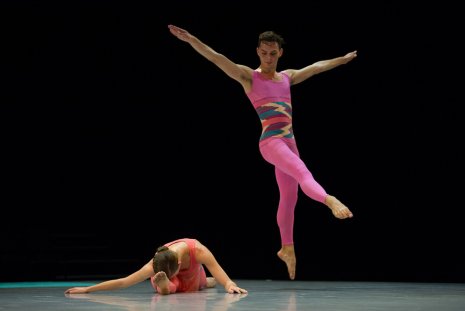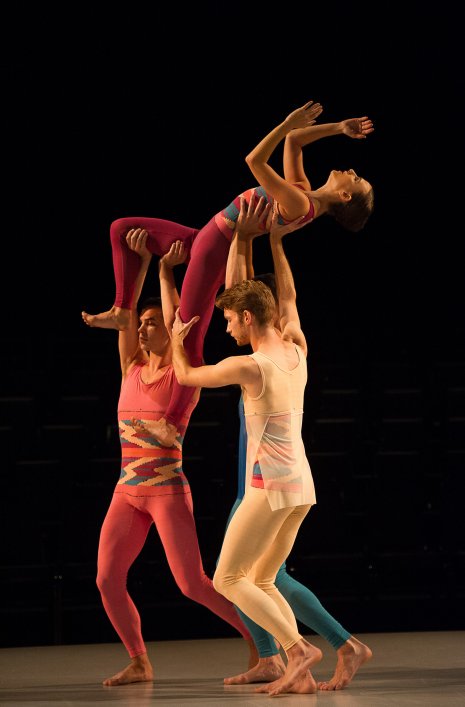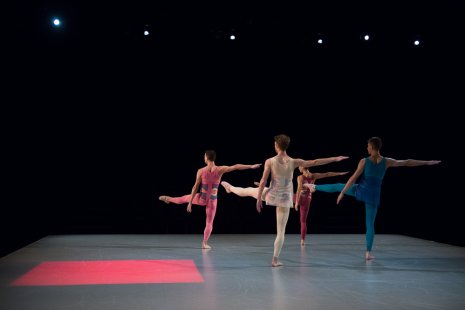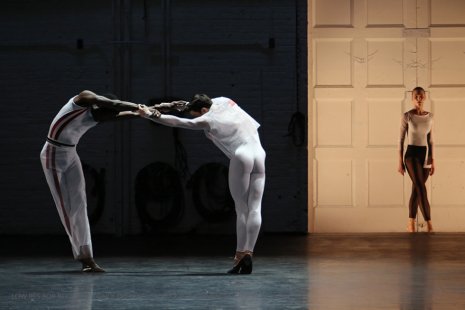Chapter Two
What I love most is being in the studio and being in the process of making a dance. I could be in the studio for the rest of my life and never do a show. I admit that dance steps are what drive me. I make dance to play with steps, turning them inside and out. I experience different combinations of steps as objects, as things that collect onto each other and then they take up space and time. I find the physicality of these steps in relation to the world as we find it and make them the frame.
For me no dance is ever finished. Each “new” dance continues the work from the one before. But always starting from a new point of view.
Confronting questions raised by traditions of dance: you can sense the presence of dance history in my work in the sensibility – from Petipa to Balanchine, to Robbins, and Cunningham and Graham – but the material, vernacular, and theatrical force are distinctly my own. I like to walk a fine line with movement, playing with it, not as parody, but exploring it like an archeologist, with curiosity and out of respect for the dances from which I have learned so much. My dances comment on history, equally revering it and revising its legacy. I also try to work out relationships between the historical dimension and personal dimension, clarifying what these references have to do with my work.
I’ve learned that in thinking about my body of work there is a way my dances may be similar - but it’s my relationship to them that keeps changing and keeps me understanding and learning how a dance can be made.
List of inspirations - no order
Petipa, Raymonda, Petrushka, Fokine, Les Sylphides, La Bayadère (Shades) Jean-Luc Godard, Band of Outsiders, Tout Va Bien, A Woman is a Women, My Life to Live, Jerome Robbins, Glass Pieces, Moves, Bottle dance from Fiddler, Truffaut, Shoot the Piano Player, 400 Blows (last frame)Paul Taylor, Scudorama, Private Domain- Rose Adagio from The Sleeping Beauty, Balanchine, Cunningham, All esp Sounddance, Quartet, Summerspace, Graham esp Steps in the Street, Tharp esp. Fugue, Eight Jelly Rolls, Bix Pieces, Mark Morris esp Gloria, Marble Halls, Bob Fosse, Eva Hesse, Miranda July, Lucinda Childs, Jacques Rivette, David Gordon, Sarah Michelson, Paul Auster, Morton Feldman, Caroline Shaw, David Lang, Kara Walker, Cy Twombly, Jorge Luis Borges, Suzanne Bocanegra, Grateful Dead, Coen Brothers, Barton Fink, Jorge Macchi, Simone De Beauvior, She Came to Stay, Alain de Botton, Louise Bourgeois, John Baldessari, Lar Von Trier, The Five Obstructions, Shelia Heti, Beatrice Wood Francois Ozon, 5x2, Janine Antoni, David Lynch, Omar Victor Diop, Rilke, Letters to a young poet, The Flaming Lips
It has been hard to write about my process and dance in a good way. Thank you Stanford!
Since I was never in a major dance company people always want to know where I came from and why I make the kind of dance I make. Maybe the answer below helps? It’s still mysterious and I think it should be
I started dancing in 4th grade with modern dance at the Steffi Nossen School in Westchester. In 8th grade my mom signed me up for a dance intensive where my teachers were Blondell Cummings and Ohad Naharin. I studied with Hannah Kahn in high school. At Ohio State I studied with Vicki Uris and John Giffin. I danced Mark Morris’ Marble Halls and made my first dance called “I only drink coffee.” At ADF [American Dance Festival] I watched dances by Bill T. Jones and Molissa Fenley, took class with Ishmael Houston Jones and Sally Silvers. I studied with Martha Myers where I made a solo with a knife and a fork. My first job in NYC was pouring coffee in the patrons lounge at NYC Ballet—where I would sneak in to the State Theater and watch tons of Balanchine and Robbins for free. But I would always miss the ends of all the ballets because I had to run out and set up the coffee.
When I began working in 1992 with just a couple of friends, I would do shows wherever and whenever I could all over NYC. My first show was at CBGB’s Gallery (I’m really showing my age!) I almost didn’t think; I just made stuff. It was naïve, but that is how I learned -- by doing. After I graduated Sarah Lawrence in 1999, I did a performance with 10 people in the audience. I self-produced and raised money for over a decade, getting my first grant at 40 years old.
I received my MFA from Sarah Lawrence College and that’s where I met Viola Farber. She taught me how to dance and to see. I took class with Dan Hurlin and Yoshiko Chuma. One of the perks of my day job at City Center was being able to watch behind the scenes rehearsals in the theater, watching ABT, TAYLOR & AILEY multiple times. I was steeped in a history lesson.
The through line for me has always been the same in some way: investigating the fundamentals of dance. Its rich, loaded history and its attendant deeply held expectations are at the core of my probing. These explorations of time-honored, codified movement vocabularies allow for new forms to be born from what has already come. Through the work, I hope to reveal something that has always existed.
########
Stanford Makishi was appointed to his current position of vice president for programming at New York City Center in 2015, after having been the associate producer of the Fall for Dance Festival since 2011. He danced with Trisha Brown from 1992 to 2006, was assistant director of her production of Winterreise, and has taught and restaged her work internationally. He also served as artistic advisor for the Ringling International Arts Festival in Sarasota, executive director of the Baryshnikov Arts Center, director of programs at the Asian Cultural Council, and director of creative services at Carnegie Hall. Makishi began his dance training in his native Honolulu and received early performance opportunities while a student at Harvard.





